Alcohol – general information
Key points about alcohol
- Alcohol (ethanol or ethyl alcohol) is an addictive toxin and intoxicant, found in beer, wine and spirits.
- Because it's addictive it's hard to stop drinking once you've started.
- As a toxin it's poisonous to the human body in large amounts and as an intoxicant it causes intoxication or an altered state.
- This page provides information about alcohol, including how it affects your body, how much alcohol is in a standard drink and how to check if your drinking is okay.
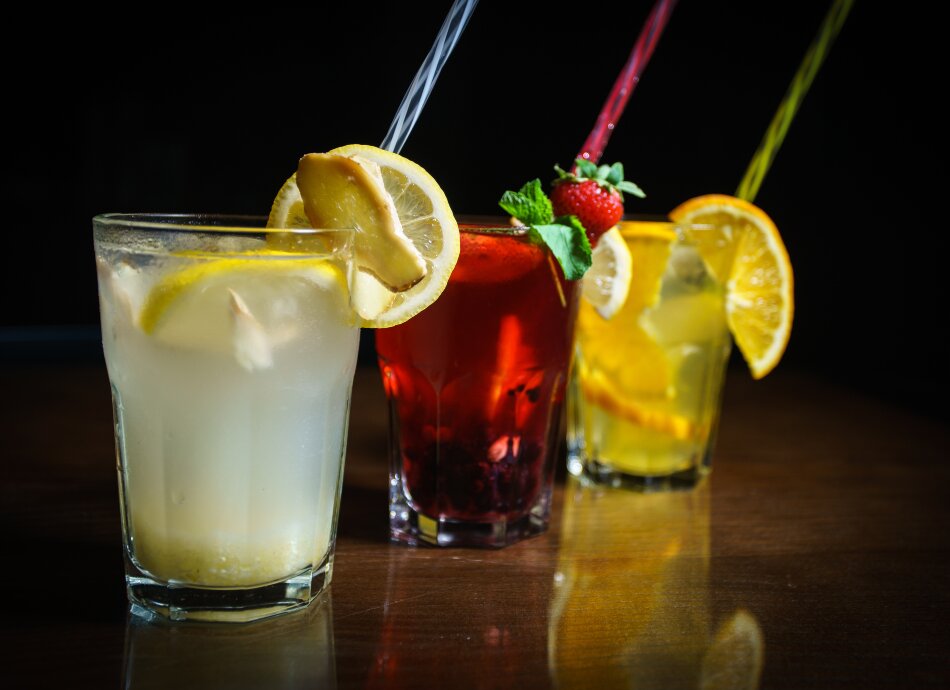
Alcohol (ethanol or ethyl alcohol) is an addictive toxin and intoxicant, found in beer, wine and spirits. An addictive substance means that you find it hard to stop taking it once you have started. Toxin means it is poisonous to the human body in large amounts. Intoxicant means it causes intoxication or an altered state.
When alcohol is swallowed, it is rapidly absorbed into your bloodstream and distributed to all parts of your body within just a few minutes. As it reaches different parts of your body, alcohol slows down the work of your cells, especially in your brain. You can feel this happening in the symptoms of the stages of intoxication and drunkenness – relaxation, laughter, slurred speech, inability to walk straight, and impaired judgement and coordination.
As alcohol travels through your stomach and intestines to your liver, it starts to be broken down (metabolised). Enzymes in your liver work hard to clear it from your body, taking 1–2 hours to break down 1 standard drink.
At low doses, alcohol can act as a stimulant that induces feelings of euphoria and talkativeness. However, it is classed as a central nervous system (CNS) depressant, which means it depresses your central nervous system at high doses and slows down your body’s reaction times and responses.
People respond to alcohol in individual ways, and the same amount of alcohol consumed can have varying effects on different people. Your reaction to alcohol is influenced by:
- the ability of your liver to break down alcohol
- your stomach contents or recent food consumption
- how much alcohol you have had and how quickly you have drunk it
- your body type and age, gender and ethnicity.
Drinking too much alcohol at one time can lead to drowsiness, respiratory depression (where your breathing becomes slow, shallow or stops entirely), coma or even death.
Recent research (August 2023) suggests that drinking even a small amount of alcohol can increase your blood pressure over time.
Use this interactive tool(external link) to learn more about your level of risk from drinking.
Alcohol contributes to the development of over 200 health conditions that can affect your quality of life. Read more about the physical effects of alcohol on your body(external link).
See also:
- What happens when I drink alcohol?(external link) Te Hiringa Hauora | Health Promotion Agency
- Key points about drinking in New Zealand(external link) Te Hiringa Hauora | Health Promotion Agency
Video: Alcohol, health and well-being
You can watch a video about alcohol, health and wellbeing by clicking the image below. It may take a few moments to load.
(World Health Organisation, 2020)
It’s not the amount of liquid you’re drinking that’s important – it’s the amount of pure alcohol.
Standard drinks are a useful and simple way to monitor how much alcohol you are drinking. Standard drinks provide a measure of the amount of pure alcohol in a drink.
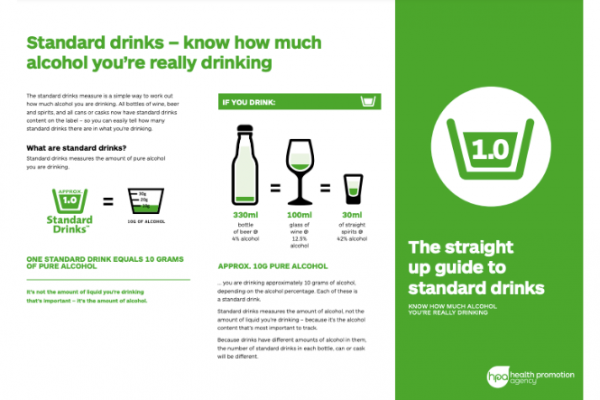
Image credit: Alcohol.org.nz
1 standard drink = 10g of pure alcohol. This is how much pure alcohol is typically found in:
- a 330 ml can of standard beer
- a 100 ml small glass of wine
- a 30 ml shot of straight spirits.
Standard drinks information can be found on a bottle, can or cask. The strength of the alcohol is important in this.
There are times and circumstances when it is advisable not to drink alcohol.
You should not drink if you:
- are pregnant or planning to get pregnant
- are on medication that interacts with alcohol
- have a condition made worse by drinking alcohol
- feel unwell, depressed, tired or cold, as alcohol could make things worse
- are about to operate machinery or a vehicle or do anything that is risky or requires skill.
Drinking too much at one go (binge drinking) or drinking too much over time (alcohol misuse) can both lead to long-term health problems.
The Health Promotion Agency’s Is Your Drinking Okay? test can help you find out more about your level of risk of harm from your drinking. Just complete the questionnaire and it will automatically add up your score and tell you what it means. It's that easy!
Take the test: Is your drinking okay?(external link)(external link)
A range of factors can affect your level of risk of harm, including the rate of drinking, your body type or genetic makeup, your gender, existing health problems and whether you are young or an older person. However it is important to recognise that alcohol is a carcinogen (a substance that can cause cancer), so even if you are drinking following the low risk drinking advice, there is no safe level of consumption.
Video: Did You Know: Alcohol
This video may take a few moments to load.
(New Zealand Drug Foundation, 2017)
For resources in other languages, visit Alcohol – Did you know?(external link)(external link) NZ Drug Foundation
Apps reviewed by Healthify
You may find it useful to look at some Alcohol use apps.
Low-risk drinking advice for adults
Low risk is not no risk. Even when drinking within low-risk limits, a range of factors can affect your level of risk, including the rate of drinking, your body type or genetic makeup, your gender, existing health problems and whether you are young or an older person.
The following advice from the Health Promotion Agency (HPA) is to help decrease your risk of alcohol-related accidents, injuries, diseases and death.
It is important to recognise that alcohol is a carcinogen (a substance that can cause cancer), so even if you are drinking following the low risk drinking advice, there is no safe level of consumption.
Reduce your long-term health risks by drinking no more than:
- 2 standard drinks a day for women and no more than 10 standard drinks a week
- 3 standard drinks a day for men and no more than 15 standard drinks a week.
Have at least 2 alcohol-free days every week.
Reduce your risk of injury on a single occasion of drinking by drinking no more than:
- 4 standard drinks for women on any single occasion
- 5 standard drinks for men on any single occasion.
A useful way to remember the number of standard drinks to lower your risk of alcohol-related harm is this chart from the Health Promotion Agency: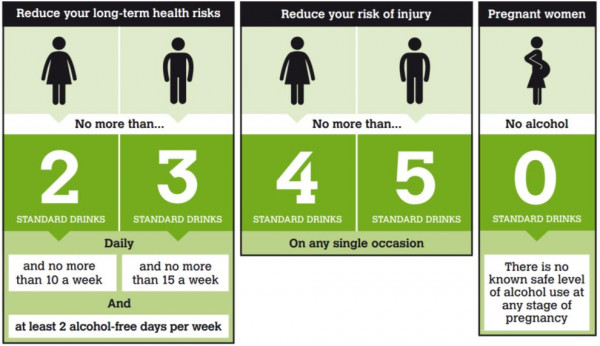
Image credit: alcohol.org.nz
The above advice is based on ‘standard drinks’. A standard drink contains 10g of pure alcohol. A common serve or pour of an alcoholic beverage is often more than 1 standard drink.
If you choose to drink alcohol, there are things you can do to help you stay within low-risk levels. These include to:
- know what a standard drink is
- keep track of how much you drink – daily and weekly
- set limits for yourself and stick to them
- start with non-alcoholic drinks and alternate with alcoholic drinks
- drink slowly
- try drinks with a lower alcohol content
- eat before or while you are drinking
- never drink and drive
- be a responsible host, eg, provide alcohol-free drinks and food and make sure everyone has a safe way to get home
- talk to your kids about alcohol
- limit your drinking to recommended safe levels
- have at least 2 alcohol-free days each week
- seek help if you feel your drinking is becoming a problem.
Video: EDTV Plan your party
The best night out is one you can remember – this video gives advice on how you can have a safe yet fun night out. This video may take a few moments to load.
(EDTV & Northland District Health Board, NZ, 2014)
Video: EDTV Be a good host
This short clip gives tips on how you can be a responsible host and make your party memorable – for all the right reasons. This video may take a few moments to load.
(EDTV & Northland District Health Board, NZ, 2014)
In Aotearoa New Zealand the alcohol laws state that a minor (person under 18 years old) cannot be supplied with alcohol unless:
- the person supplying the alcohol is their parent or legal guardian AND the alcohol is supplied in a responsible manner, OR
- the person supplying alcohol has the express consent of the teenager’s parent or legal guardian AND the alcohol is supplied in a responsible manner.
You could be fined up to $2,000 if you don’t follow this law.
As a parent or guardian you should:
- supervise the consumption of alcohol
- provide food
- provide a choice of low-alcohol and/or non-alcoholic drinks
- ensure safe transport options are in place.
Important: If a teenager or minor in your care is drunk and unconscious, call 111.
The brain is still developing in young people up to the age of 25 years, making children and young people especially vulnerable to the effects of alcohol.
Young people with their developing bodies and brains have a lower tolerance to alcohol than adults and are susceptible to more and different harms. Alcohol negatively impacts on memory and learning, thinking and processing, and mental health.
Video: Under Construction: Alcohol and the Teenage Brain
This video may take a few moments to load.
(Turning Point Training, Australia, 2013)
Young people who drink alcohol are more likely to:
- experience an injury or accident related to alcohol use
- find themselves involved in an assault or arrested
- have unprotected and unwanted sex
- experience other harmful effects on their social life, finances or work/study
- be at risk of alcohol dependence.
Not drinking alcohol is the safest option for children and young people. Delaying alcohol consumption for as long as possible is advised.
If children or young people are drinking or considering drinking alcohol:
- delay drinking for as long as possible
- supervise events or situations where there may be alcohol
- support initiatives to minimise the amount drunk
- provide positive role models in the child or young person’s life
- encourage open conversation and trusting relationships about alcohol use and its impacts.
Alcohol Drug Helpline – Youth Helpline(external link) Call 0800 787 YTH (0800 787 984) any day, 24 hours a day, or FREE TXT 8681 and a counsellor will TXT you back.
Te Hiringa Hauora | Health Promotion Agency's advice for parents and caregivers. Find practical information for parents and caregivers out about:
- Delaying introducing alcohol and being a good role model(external link)
- What the law says about supplying to young people (external link)
- What to do when things go wrong(external link)
- Alcohol and your kids (download or order booklet)(external link)
Alcohol and you – an NHS self help guide(external link) NHS, UK
No amount of alcohol is good for your heart(external link) Heart Foundation, NZ
Brochures
- Short-term effects of drinking alcohol (external link)Te Hiringa Hauora | Health Promotion Agency, NZ, 2018
- Long-term effects of drinking alcohol(external link) Te Hiringa Hauora | Health Promotion Agency, NZ, 2017
- Energy in alcoholic drinks(external link) HPA, NZ, 2019
- Standard and drink guidelines in all languages(external link) Matua Raki, NZ
- Alcohol & your kids – What can you do?(external link) Te Hiringa Hauora | Health Promotion Agency, NZ, 2015
Apps
Reference
- Di Federico S, Filippini T, Whelton PK, et al. Alcohol intake and blood pressure levels – a dose-response meta-analysis of nonexperimental cohort studies(external link). Hypertension 2023;80
See our page Youth health for healthcare providers
Brochures
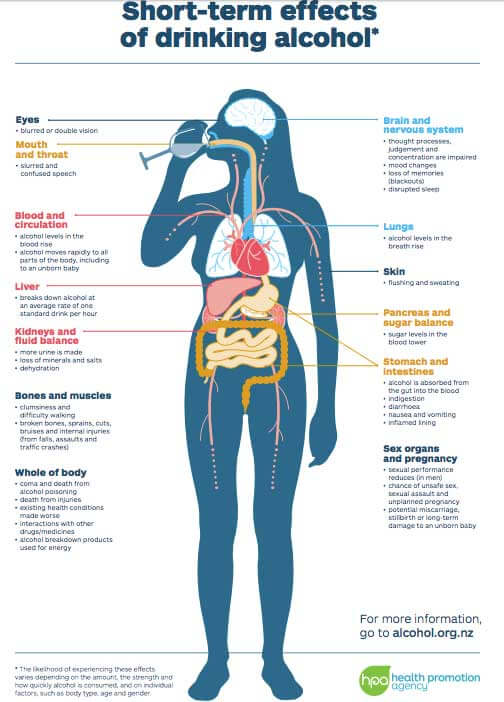
Te Hiringa Hauora | Health Promotion Agency, NZ, 2018
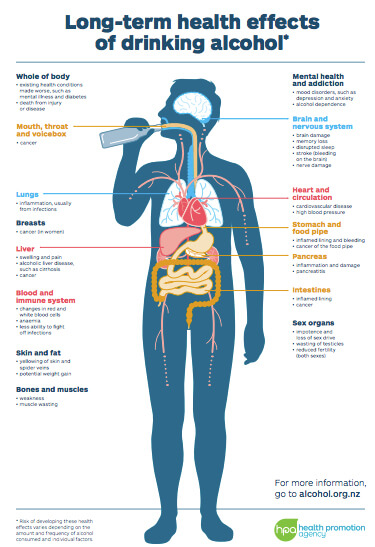
Te Hiringa Hauora | Health Promotion Agency, NZ, 2017

Te Hiringa Hauora | Health Promotion Agency, NZ, 2015
Credits: Healthify Editorial Team
Reviewed by: Luisa Silailai, Programme Manager for Alcohol Harm Minimisation and accredited DAPAANZ Clinical Supervisor/Alcohol and other Drugs and Problem Gambling Clinician.
Last reviewed:
Page last updated:





